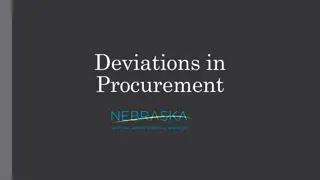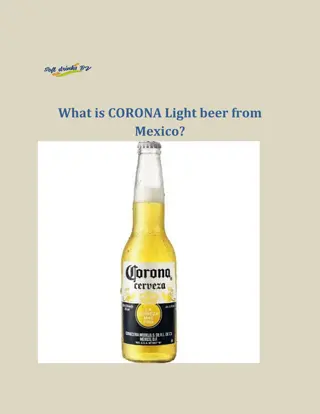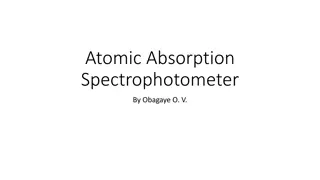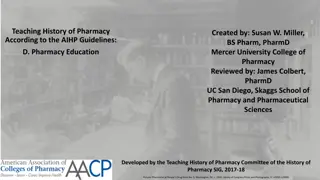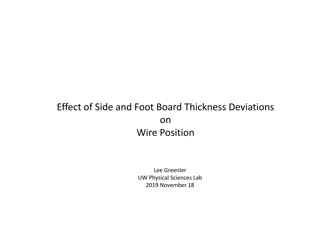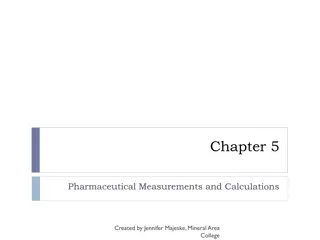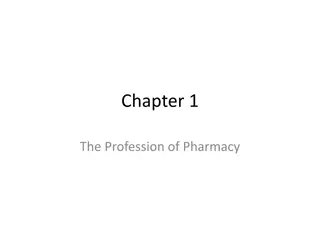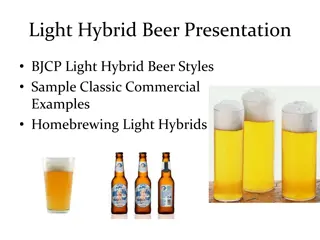Advanced Analysis in Pharmacy: Deviations from Beer-Lambert Law
Explore the complexities of advanced analysis in pharmacy through deviations from Beer-Lambert Law, including real, instrumental, and chemical deviations. Understand limitations, causes of nonlinearity, and the role of instrumentation in spectrophotometry. Dive into topics such as irregular and regular instrumental deviations, chemical deviations, and factors affecting linearity. Gain insights into the use of spectrophotometers and measurement techniques in analyzing light intensity as a function of wavelength.
Download Presentation

Please find below an Image/Link to download the presentation.
The content on the website is provided AS IS for your information and personal use only. It may not be sold, licensed, or shared on other websites without obtaining consent from the author. Download presentation by click this link. If you encounter any issues during the download, it is possible that the publisher has removed the file from their server.
E N D
Presentation Transcript
Lecture3 Advanced Analysis for Pharmacy Students By Professor Dr. Mohie Sharaf El Din
DEVIATION FROM BEER,S LAW a - Real Deviation : -dilution effect - molecular interaction -complex formation Real Deviation Instrumental Deviation Chemical Deviation
b - Instrumental Deviation (Errors) 1 - Irregular Deviation -unmatched cells -unclean optics ( cells - lenses - mirrors - lamps ) 2 - Regular Deviation - error in wavelength scale - slit-width -stray light 3 - Non linear response of the phototubes - Radio and TV interference's - Voltage fluctuations
c - Chemical Deviations pH effect - solvent effect - temperature effect - photodegradation time factor ( oxidation - reduction - hydrolysis - polymerization )
Limitations of the Beer-Lambert law The linearity of the Beer-Lambert law is limited by chemical and instrumental factors. Causes of nonlinearity include: deviations in absorptivity coefficients at high concentrations (>0.01M) due to electrostatic interactions between molecules in close proximity scattering of light due to particulates in the sample fluoresecence or phosphorescence of the sample changes in refractive index at high analyte concentration shifts in chemical equilibria as a function of concentration non-monochromatic radiation, deviations can be minimized by using a relatively flat part of the absorption spectrum such as the maximum of an absorption band stray light
INSTRUMENTATION Spectrophotometry involves the use of a spectrophotometer. A spectrophotometer is a photometer (a device for measuring light intensity) that can measure intensity as a function of the color, or more specifically, the wavelength of light. There are many kinds of spectrophotometers. Among the most important distinctions used to classify them are A. the wavelengths they work with(200 -900 nm, uv/vissible spectrophotometer ), B. the measurement techniques they use (infra red spectrophotometer , spectrofluorometer, atomic absorption spectrophotometer) .
the most common application of spectrophotometers is the measurement of light absorption. The most common spectrophotometers are used in the UV (200 400nm) and visible (400 700nm) regions of the spectrum, and some of these instruments also operate into the near-infrared region as well. Visible region spectrophotometry is used extensively in colorimetry science . There are two major classes of spectrophotometers; single beam and double beam.
The single beam spectrophotometer was the first invented, and all the light passes through the sample. In this case, to measure the intensity of the incident light, the sample must be removed so all the light can pass through (using blank solvent). This type is cheaper because there are less parts and the system is less complicated.
The double beam spectrophotometer In this type, the light source is split by a rotating mirror into two equal Intensity beams before it reaches the sample. One beam passes through the reference compartment containing only solvent and the other passes through the sample. This is advantageous because the reference reading and sample reading can be taken at the same time. In some double beam spectrophotometers, there are two detectors and the sample and reference beams can be measured simultaneously. Other double beam spectrophotometers that have only one detector use a beam chopper. This device inside blocks one beam at a time and the detector alternates between measuring the sample and reference beams
A double beam spectrophotometer measures the ratio of the light intensity on two different light paths, and a single beam spectrophotometer measures the absolute light intensity. The output of a spectrophotometer is usually a graph of light intensity versus wavelength (Absorption curve).
the sequence of events in a spectrophotometer is as follows: The light source shines through the sample. The sample absorbs light. The detector detects how much light the sample has absorbed. The detector then converts how much light the sample absorbed into a number. The numbers are either plotted straight away, or are transmitted to a computer to be further manipulated (e.g. curve smoothing, baseline correction) giving the absorption curve .
If the sample compound does not absorb light of a given wavelength ,I = Io. However, if the sample compound absorbs light then I is less than Io and this difference may be plotted on a graph versus wavelength, Absorption may be presented as transmittance( T = I/Io (or absorbance( A =log I/Io) .If no absorption has occurred, T = 1.0 and A =0 . Most spectrometers display absorbance on the vertical axis, and the commonly observed range is from 0 (100% transmittance) to 2 (1% transmittance). The wavelength of maximum absorbance is a characteristic value, designated as max.
Different compounds may have very different absorption maxima and absorbances. Intensely absorbing compounds must be examined in dilute solution, so that significant light energy is received by the detector, and this requires the use of completely transparent (non-absorbing) solvents. The most commonly used solvents are water, ethanol, hexane and cyclohexane. Solvents having double or triple bonds, or heavy atoms (e.g. S, Br & I) are generally avoided. Because the absorbance of a sample will be proportional to its molar concentration in the sample cuvette, a corrected absorption value known as the molar absorptivity is used when comparing the spectra of different compounds. This is defined as :Molar Absorptivity, = A /cb (where A = absorbance ,c = sample concentration in moles/liter, b = length of light path through the cuvette in cm.
Spectrophotometers A spectrophotometer is a device to measure light intensity at different wavelengths. It produces light with a light source, and after the light passes through a subject, the light is diffracted into a spectrum which is detected by a sensor and interpreted into results we can use. Components of Spectrophotometer 1- source of light 2 monochromator 3 sample component 4 detector 5 - meter
1 - Radiation Source The radiation used for spectrometric measurements must be intense and stable For the UV region, the radiation source is a Hydrogen or deuterium discharge lamp that emits polychromatic UV radiation which can then be filtered into monochromatic UV radiation. The instrument scans a wavelength region from 150nm to 350 nm allowing a monochromatic UV radiation to pass through the sample. When there is sufficient amount of energy from the radiation source then energy will be absorbed and the instrument compares the intensity before and after passing through the sample. The absorbance is recorded on the "y" axis and the wavelength scan on the "x" axis of a graphic display .
For the Vissble Region the radiation source must be changed to a tungsten filament similar to the ones found in a common light bulb. The glowing of the filament produces a polychromatic visible radiation source (i.e: white light). The instrument filters out all but one wavelength and passes it through the sample. The wavelengths are scanned from 400 nm (violet) to 750 nm (red). Those samples whose lamda max is closer to the 400 nm side will appear redder. Those samples whose lamda max is nearer the 750 nm end will appear more blue. The way the absorbance is registered is the same as in the UV region .
2 Monochromator : dispersion of polychromatic radiation into monochromatic radiation. Monochromatic light may be obtained by one of the following methods A filter : functioning by selective absorption of unwanted wavelengths and transmitting the compllementary colour. B prisms : functioning via refraction of light (figure). C- gratings: consists of a large number of parallel grooves ruled very close to each other on a highly polish surface eg. aluminium or other metal (300 - 2000 groove/mm). Each ruled groove functions as a scattering center for light falling on its edge and through diffraction and interference the grating disperses the light beam into almost single wavelength (figure).
3 - Sample Compartment For UV spectra the sample must be placed in sample compartments made of quartz since quartz will not absorb in the UV region except at very short wavelengths (vacuum UV). This makes the sample compartments very expensive. If one uses a double beam instrument, the monochromatic radiation is split by a rotating mirror into two equal Intensity Beams. One goes through the sample compartment and one goes through a reference compartment containing only solvent if any is used in preparing the sample. This means that you must have a matched pair of quartz UV cells . For the visble region, compartments composed of simple pyrex glass is sufficient since pyrex will absorb in the UV but will not absorb in the visible region .
4 detectors Convert the radiant energy into an electric current which is proportional to light intensity. A photocells : the light( radiant energy ) falls on the cathode surface which exites electrons and generate an electric current which is proportional to light intensity. B phototubes (photomultiplier tubes) : give greater sensitivity . Used when light signal is weak. Composed of a photocathode and several anodes of gradually increase potential. Electrons from the photocathode are attracted to anode1 and liberate more electrons which travel to anode 2 due to its higher potential and so on to the last anode. The final current is many times greater. Signals from photo cells or phototubes are then passed through amplifier to enhance the response, then passed to the recorder.
5 Recorder (meters): many types are used such as galvanometers, electric recorders or electriccells to give digits. All may the connected to a computer which can give final data ( spectrum or concentration).
APPLICATIONS UV spectra and Visible spectra can be used to identify an unknown compound by a comparative analysis. One can compare the UV or Visible spectra of the unknown with the spectra of known suspects. Those that match are evidence that they could be one and the same. However using a match on UV or Visible is not conclusive. Usually IR and Proton NMR spectra must nail down the exact identification. Companies publish catalogs containing IR, UV, Visible, Proton NMR, C-13 NMR, and mass spectra of known compounds for comparison.
UV and Visible spectra can also be used to determine the concentration of a chromaphore compound in a mixture using the Beer Lambert Law. Usually 3-5 standard sample of the chromaphore are prepared, and the absorbance of each standard is measured. The Absorbance can be plotted against the concentration and a standard curve can be generated. By measuring the absorbance of the unknown mixture, one can locate the absorbance on the "y" axis of the Standard curve, draw a perpindicular over till it intersects the standard curve and then a perpindicular down until it intersects the "x" axis. At the point of intersection on the "x" axis, the concentration of the chromaphore can be determined. Of course, only one chromaphore may absorb at the wavelength used to measure the standards .
One can also use a proportional method where the Absorbance of a known concentration sample is measured and the Absorbance of the unknown can be measured. Then at lamda max : Ax = abcx Astd = abcstd Since the b, the path length and the extinction coeff will be constant : Ax / Cx = b(extinction coeff ( Astd / Cstd = b (extinction coeff ( Ax / Cx = Astd / Cstd )Ax( )Cstd / )Astd (= Cx
A Qualitative Analysis : 1 - Identification through comparison of max, , A1% , A 1 - A 2 and A 1 / A 2 between sample and standard . 2 identification of structure features through 1 - UV - Visible - Spectrum 2 - IR - Spectrum 3 - NMR -Spectrum 4 - Mass Spectrum
B - Quantitative Analysis 1 - Determinations of inorganic compounds a Cu forms blue colour with ammonia b Fe(III) forms red colour with thiocyanate c Fe(II) form red complex with 1,10- phenanthroline 2 - Determinatins of organic compounds a for aromatic primary amines: diazotisation and coupling forming red complex . b phenols: coupling with diazotised primary aromatic amines forming red complex . c carbonyl compounds: by reaction with 2,4- dinitrophenylhydrazine forming red complex .
C Determination of pka of an indicator pKind = pH - log [In-]/[HIn] Where [In-] and [HIn] are the molar conc. of ionized and unionized forms of the indicator and they have strong absorption in uv or visible region : HIn H+ + In-
Spectrophotometric titrations In this type of titration the end point is detected spectrophotometrically,where one of the reaction components (titrant ,reactant or product) has absorption in the uv or visible regions Advantages: 1 can be used for titration of very dilute solutions 2 can be used with out interference from other substance 3 photometric titrations are often more accurate than direct photometric determinations. Titration curve: A photometric titration curve is a plot of absorbance as a function of titrant volume. The curve consists of two straight-lines with different slopes, one occurring prior to the EP ,and the other beyound the EP. The EP is taken as the intersection of the extrapolated of the two lines. Figures:
Sample + Reagent Product A ml of titrant Only sample is coloured
Only Reagent is coloured A A Ml titrant
A ml titrant sample and Reagent are coloured
Only product is colored A ml titrant
Clinical Determination of Alanine Aminotransferase (ALT/GPT) in clinical samples Determination of cholesterol in clinical samples Determination of glucose in clinical samples Determination of urea in clinical samples Determination of phosphate in clinical samples
Food and Drink Summaries of Official Spectrophotometric Methods (2 :)Food Analysis Summaries of Official Spectrophotometric Methods (3): Agricultural Supplies Analysis Determination of L-ascorbic acid in fruit juice samples Determination of D-malic acid in fruit juice samples Spectral Analysis of Fruit Juices Measurement of honey quality Measurement of olive oil quality Measurement of maple syrup quality
Industrial / Pharmaceutical Summaries of Official Spectrophotometric Methods (1): Drug Analysis Summaries of Official Spectrophotometric Methods (4): Pharmaceuticals and Cosmetics Life Sciences The Measurement of Bull Sperm Density and Dosage for Artificial Insemination Applications of UV/Visible Spectrophotometers in the Life Sciences Laboratory Nucleic Acid, Protein and Cell Growth measurement using Gene Quant pro Application of Tm to Drug Discovery








